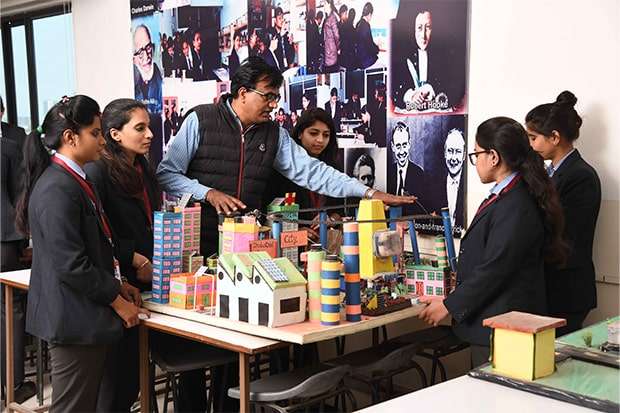Science Lab
Faculty In charge – Dr. Rajesh Kumar Sharma
Centre for Teacher Education, IPEM, GZB motivates and train pupil teachers to use Science Lab technically. Aim & Objective of introducing Science lab are developing the insights, competencies, and skills among the students to attain the curriculum aims, and objectives effectively through the use of different methods, strategies, and techniques. Theory is taught by teacher centered methods to learner centered methods. Laboratory methods are an important strategy for teaching science. Laboratory activities aim at achieving affective and psychomotor skills. Practical subjects include physics, chemistry, and biology. Students use the laboratories during teaching practice. Initial preparation in the conduct of experiments and use of apparatus is practiced at the laboratories.
Objectives:
- To develop Experimental &data analysis skills in B.Ed. Students.
- To give practical experiences &develop scientific understanding of the physical world.
- To develop an ability to express themselves coherently and logically.
- To verify the theoretical knowledge & develop the skills with science lab.
The Science Lab has the followings Equipments
List of Biology Science Equipments
| 1. Prepared Slides in Zoology | 2. Prepared Slides in Botany | 3. Human Skeleton |
| 4. Frog Skeleton | 5. T.S Dicot Root- Model | 6. T.S Dicot Stem-Model |
| 7. T.S Monocot Root-Model | 8. T.S Monocot Stem-Model | 9. Plant Cell-Model |
| 10. Human Brain-Model | 11. Heart-Model | 12. Human Eye-Model |
| 13. Human Stomach-Model | 14. Watch Glasses | 15. Round Cover Slip Box |
| 16. Square Cover Slip Box | 17. Empty Slides-1 Box | 18. Eosin Gel |
| 19. Eosin Red | 20. Specimens of Animals & Plants |
List of Science Lab:-Physics Equipments, Chemicals & Apparatus
| 1. Brush | 2. Lens Stand | 3. Test Tube Holder |
| 4. Beaker | 5. Solution Bottle | 6. Funnel |
| 7. Burette | 8. Solar Cooker | 9. Volumetric Flask |
| 10. Kandy Normality Apparatus | 11. Plane Mirror | 12. Convex Lens |
| 13. Concave Lens | 14. Watch Glass | 15. Stopwatch |
| 16. Vernier Caliper’s | 17. Small Prism | 18. Pipette |
| 7. T.S Monocot Root-Model | 17. Empty Slides-1 Box | 2. Lens Stand |
| 8. T.S Monocot Stem-Model | 18. Eosin Gel | 2. Lens Stand |
| 19. Voltmeter | 20. Ammeter | 21. Litmus Red Solution |
| 22. Litmus Blue Solution | 23. Thermometer | 24. Magnet |
| 25. Analytical Weight Box | 26. Boss Head | 27. Magnetic Compass |
| 28. Dropper’s | 29. Thom Land Paper (One Pack) | 30. Mirror |
| 31. Screw Gauze | 32. Glass Slab | 33. Bobs Brass Pendulum |
| 34. Potassium dichromate | 35. Potassium Iodide | 36. Cadmium Carbonate |
| 37. Xylene Sulphur Free | 38. Glycerol | 39. Manages Dioxide |
| 40. Aluminum Chloride | 41. Nickel Sulphate | 42. Cupric Sulphate |
The list of Experiments in Science Lab-
Biology Practical:-
- Dissection of Different Parts of flower.
- Spotting of Specimens and Slides.
- To prepare slides through mounting.
- The Cell study of Onion peel.
Physics Practical:-
- To verify the law of reflection of sound.
- To determine the density of a given solid by using a spring balance and a measuring cylinder. To assemble the components of a given electrical circuit.
- To calculate the time period through simple pendulum.
- To measure the diameter of small spherical/cylindrical body through Vernier Callipers.
- To measure the diameter of given wire through Screw Gauge.
- To determine the focal length of spherical mirrors.
Chemistry Practical: –
- To separate the Components of a mixture of sand, common salts
and ammonium chloride (or camphor) by sublimation.
- To test the presence of adulteration of
- Metanil yellow in dal.
- Paraffin wax and hydrocarbon in vegetable ghee
- Dyes in fat
- Argemone oil in edible oils
- Various insoluble substance in sugar
- Chalk powder washing soda in sugar
- Yellow lead salts to turmeric powder.
- To prepare:
- A mixture (b) a compound
By Using iron filings and Sulphur powder and distinguish between
them on the basis of the following
(i) Appearance i.e., homogeneity or heterogeneity
(ii) Behaviour towards a magnet
(iii) Behaviour towards carbon disulphide (a solvent).
- To Check the Acid & Basic Radicals in given Mixture.








